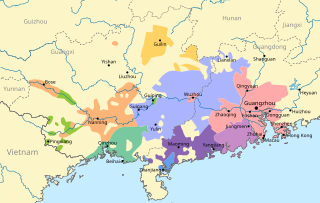

| Siyi | |||||||||||||||||
|---|---|---|---|---|---|---|---|---|---|---|---|---|---|---|---|---|---|
| Seiyap, Sze Yup | |||||||||||||||||
| Native to | Guangdong, China; Sze Yup Chinese communities in Hong Kong, Southeast Asia and the Americas. | ||||||||||||||||
| Region | Sze Yup | ||||||||||||||||
Native speakers | 3.9 million (2010)[citation needed] | ||||||||||||||||
| Dialects | |||||||||||||||||
| Language codes | |||||||||||||||||
| ISO 639-3 | None (mis) | ||||||||||||||||
| ISO 639-6 | siiy | ||||||||||||||||
| Glottolog | siyi1236 | ||||||||||||||||
| Linguasphere | 77-AAA-mb | ||||||||||||||||

Siyi (lower right), among other Yue and Pinghua groups in Guangxi and Guangdong | |||||||||||||||||
| Chinese name | |||||||||||||||||
| Chinese | 四邑方言 | ||||||||||||||||
| |||||||||||||||||
| Alternative Chinese name | |||||||||||||||||
| Chinese | 四邑話 | ||||||||||||||||
| |||||||||||||||||
Siyi (SeiyaporSze Yup in Cantonese; Chinese: 四邑方言; pinyin: Sìyì fāngyán; Jyutping: sei3 jap1 fong1 jin4 meaning "Four Hamlets") is a coastal branch of Yue Chinese spoken mainly in Guangdong province, but is also used in overseas Chinese communities. Within the province, it is mainly spoken in the prefecture-level cityofJiangmen, but pockets exist outside Jiangmen, including the Doumen and Jinwan districts in Zhuhai, GuzheninZhongshan and Jun'aninFoshan. Taishanese, which was one of the most important Chinese dialects in Chinese American communities, is considered a representative dialect.
The name "Sze Yup" or "Seiyap" (Chinese: 四邑; pinyin: Sìyì; Cantonese Yale: sei yāp; lit. 'Four Counties') refers to the historical four counties of Jiangmen prefecture: Xinhui, Taishan, Enping and Kaiping.
Since a fifth county, Heshan, was added to the prefecture in 1983, this region is referred to as the "Five Counties" (Chinese: 五邑; pinyin: Wǔyì; Cantonese Yale: nǵh yāp) in the province; but for historical reasons, the term "Seiyap" is still used amongst the overseas Chinese communities.
It has also been called Delta Cantonese[1] because all the aforementioned counties are in the Pearl River Delta.
The Siyi dialect is mainly distributed along the drainage basin of the Tan river (Chinese: 潭江), as well as part of the region west of the main stream of the Xi River, near to the confluence of the two rivers. Most of the region in which Siyi is spoken is administered by the prefecture-level city of Jiangmen, including the Jiangmen city districtsofJianghai, Pengjiang and Xinhui, as well as the county-level citiesofTaishan, Kaiping, Enping and the southeastern part of Heshan, but the dialect is also spoken in parts of Zhuhai, the town of Guzhen in Zhongshan and the town of Jun'an in Foshan. In terms of geographic extremes, Siyi is spoken furthest north in Yayao (雅瑶), Heshan; furthest south in Xiachuan Island, Taishan; furthest east in Hongqi (红旗), Zhuhai; and furthest west in Naji (那吉), Enping. The total geographic area of the region is approximately 9000 square kilometers and the total number of speakers is estimated at 3.9 million in 2010.
|
Sino-Tibetan branches
| |||||
|---|---|---|---|---|---|
| Western Himalayas (Himachal, Uttarakhand, Nepal, Sikkim) |
| ||||
| Eastern Himalayas (Tibet, Bhutan, Arunachal) |
| ||||
| Myanmar and Indo-Burmese border |
| ||||
| East and Southeast Asia |
| ||||
| Dubious (possible isolates) (Arunachal) |
| ||||
| Proposed groupings |
| ||||
| Proto-languages |
| ||||
Italics indicates single languages that are also considered to be separate branches. | |||||
|
| |||||||||||||||||||||||||||||||||||||||||||||||||||||||||||||||||||||
|---|---|---|---|---|---|---|---|---|---|---|---|---|---|---|---|---|---|---|---|---|---|---|---|---|---|---|---|---|---|---|---|---|---|---|---|---|---|---|---|---|---|---|---|---|---|---|---|---|---|---|---|---|---|---|---|---|---|---|---|---|---|---|---|---|---|---|---|---|---|
| Major groups |
| ||||||||||||||||||||||||||||||||||||||||||||||||||||||||||||||||||||
| Standard forms |
| ||||||||||||||||||||||||||||||||||||||||||||||||||||||||||||||||||||
| Phonology |
| ||||||||||||||||||||||||||||||||||||||||||||||||||||||||||||||||||||
| Grammar |
| ||||||||||||||||||||||||||||||||||||||||||||||||||||||||||||||||||||
| Idioms |
| ||||||||||||||||||||||||||||||||||||||||||||||||||||||||||||||||||||
| Input |
| ||||||||||||||||||||||||||||||||||||||||||||||||||||||||||||||||||||
| History |
| ||||||||||||||||||||||||||||||||||||||||||||||||||||||||||||||||||||
| Literary forms |
| ||||||||||||||||||||||||||||||||||||||||||||||||||||||||||||||||||||
| Scripts |
| ||||||||||||||||||||||||||||||||||||||||||||||||||||||||||||||||||||
This Sino-Tibetan languages-related article is a stub. You can help Wikipedia by expanding it. |